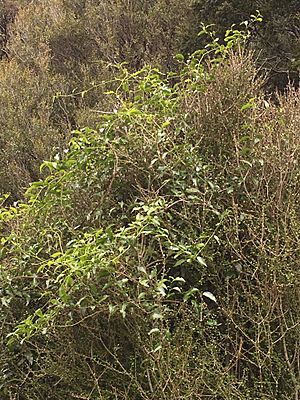Passiflora tetrandra facts for kids
Quick facts for kids Passiflora tetrandra |
|
|---|---|
 |
|
| Scientific classification | |
| Genus: |
Passiflora
|
| Species: |
tetrandra
|
| Synonyms | |
|
|
Passiflora tetrandra is a special climbing plant, or vine, that grows only in New Zealand. The Māori people call it kōhia. You might also hear it called the New Zealand passionflower or New Zealand passionfruit. It's unique because out of about 500 different types of passionflowers around the world, kōhia is the only one that naturally lives in New Zealand. This means it is endemic to New Zealand, found nowhere else in the wild.
What is Kōhia?
Kōhia is a forest vine. It can climb very high, sometimes up to 10 meters (33 feet) tall. Its leaves are shiny green and shaped like a spearhead. They grow one after another along the stem. The edges of the leaves are smooth, not toothed.
Flowers and Fruit
Kōhia plants have small flowers. They are usually white or light yellow. These flowers grow in groups of one to three where the leaves meet the stem. You can see the flowers between October and December.
How Kōhia Reproduces
Kōhia plants are dioecious. This means that a single plant has either only male flowers or only female flowers. For the plant to make fruit, pollen from a male-flowering plant must reach a female-flowering plant. If a female plant doesn't get pollen from a male plant, it won't produce fruit.
The fruit of the kōhia plant grows from summer to autumn. It looks like a small lemon and is orange when ripe. The fruit can be up to 30 millimeters (1.2 inches) long.
Uses of Kōhia
The fruit of the kōhia plant can be eaten by people. It was a traditional food for the Māori people. They also used to chew the sticky sap, or gum, that came from the stem of the vine.
Growing Kōhia
You can grow new kōhia plants from seeds or from cuttings. Cuttings are small pieces of the plant that can grow roots. Kōhia vines need a support structure to climb on, like a tree or a trellis. They also like to have their roots in cool, good quality soil.


